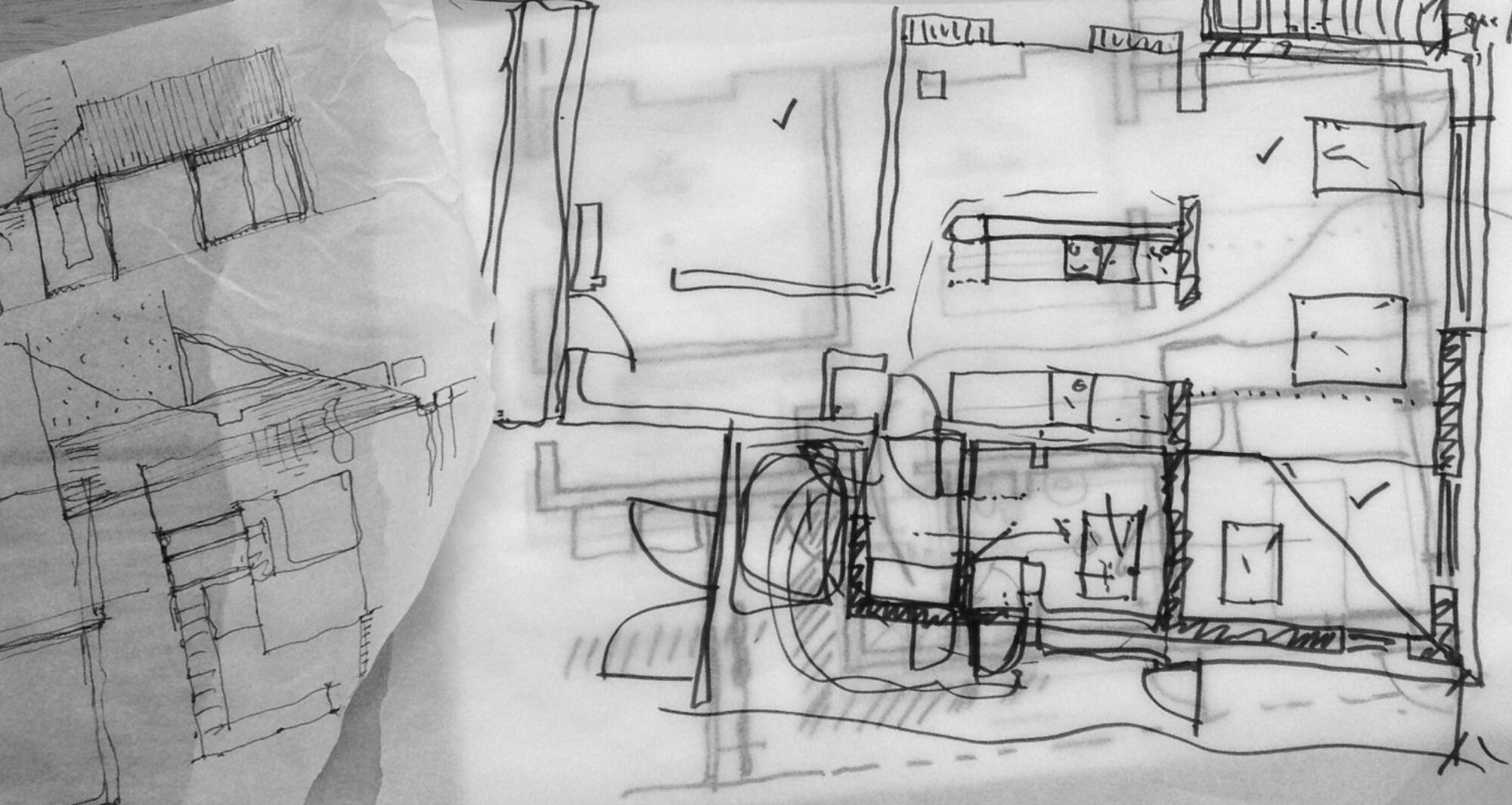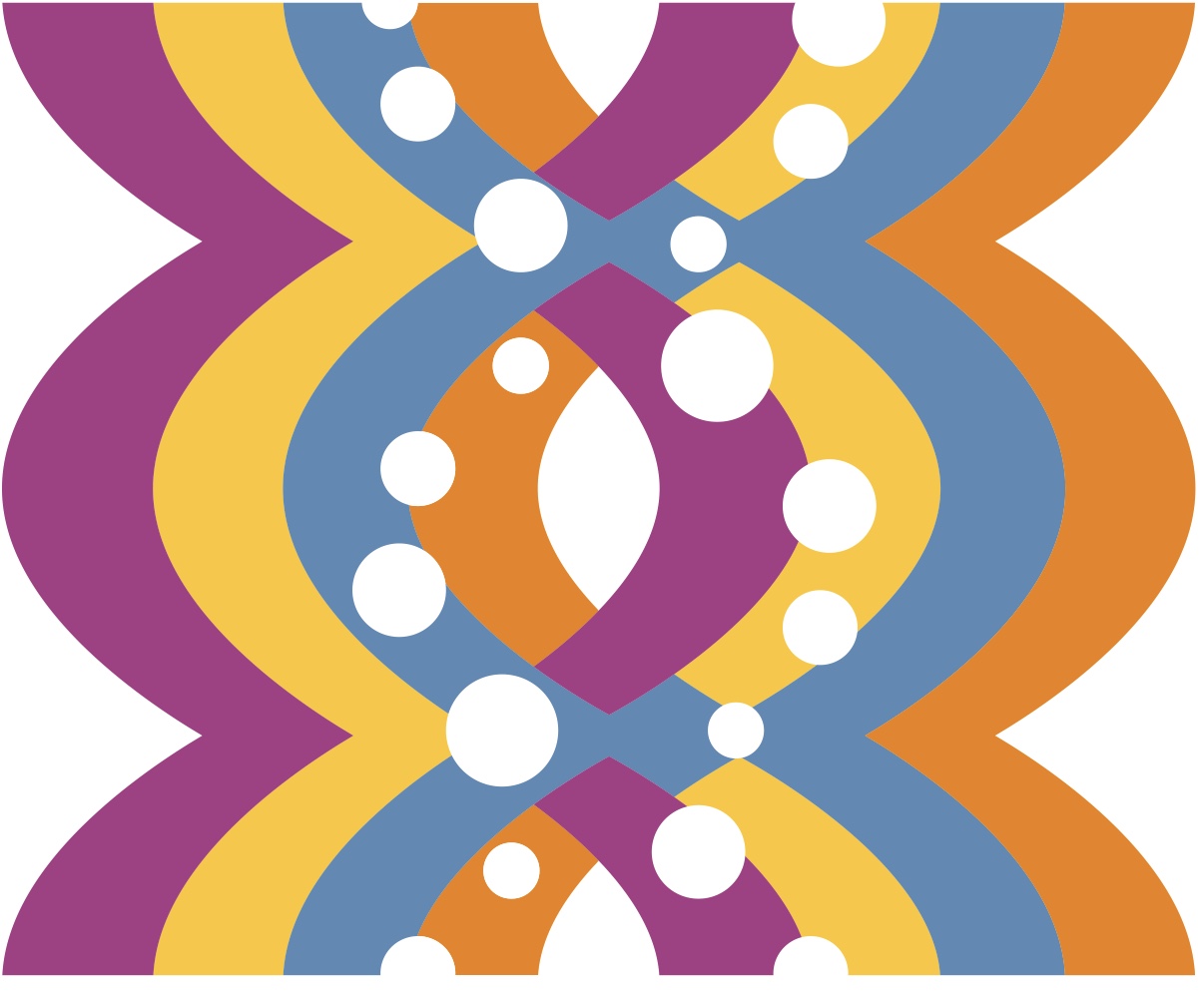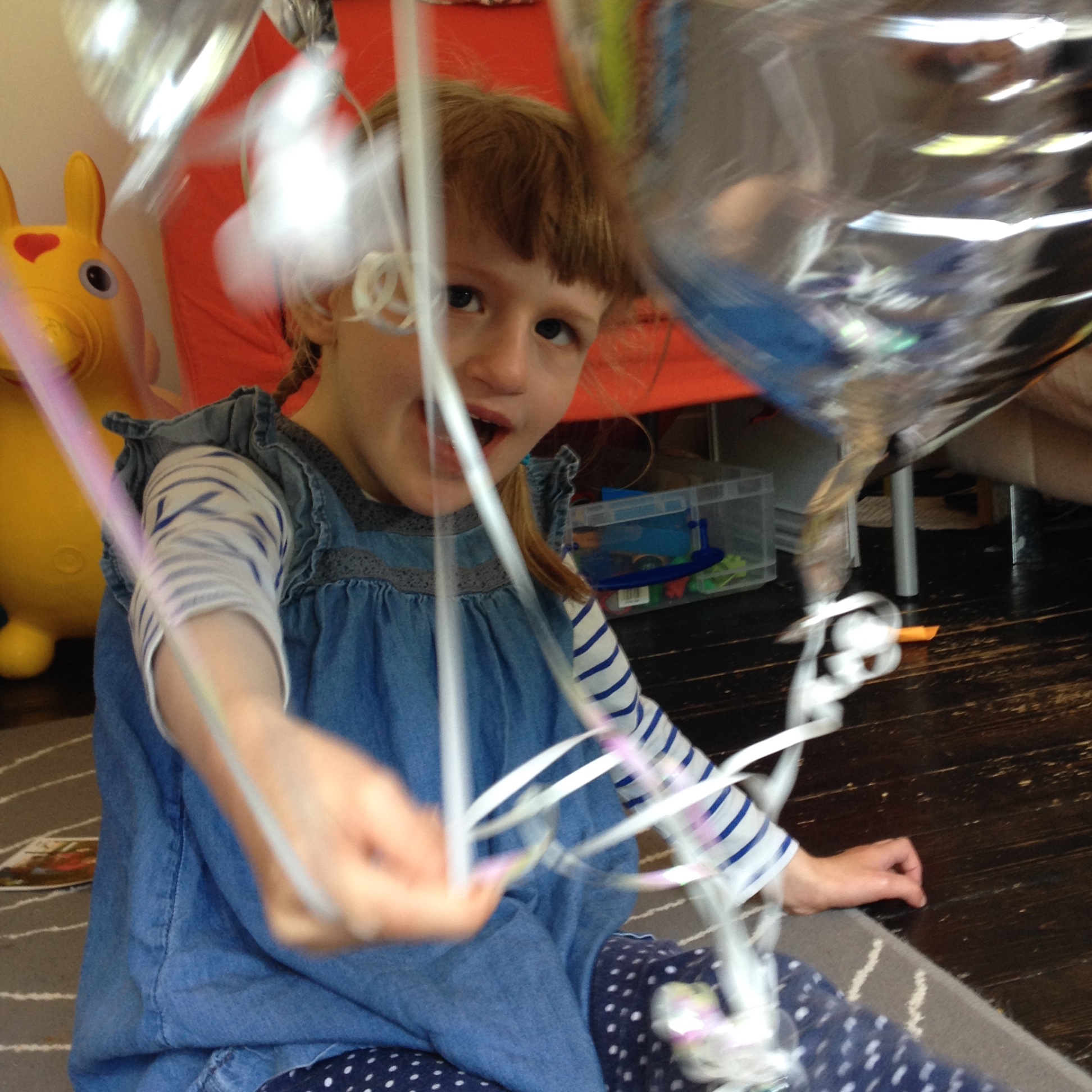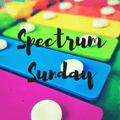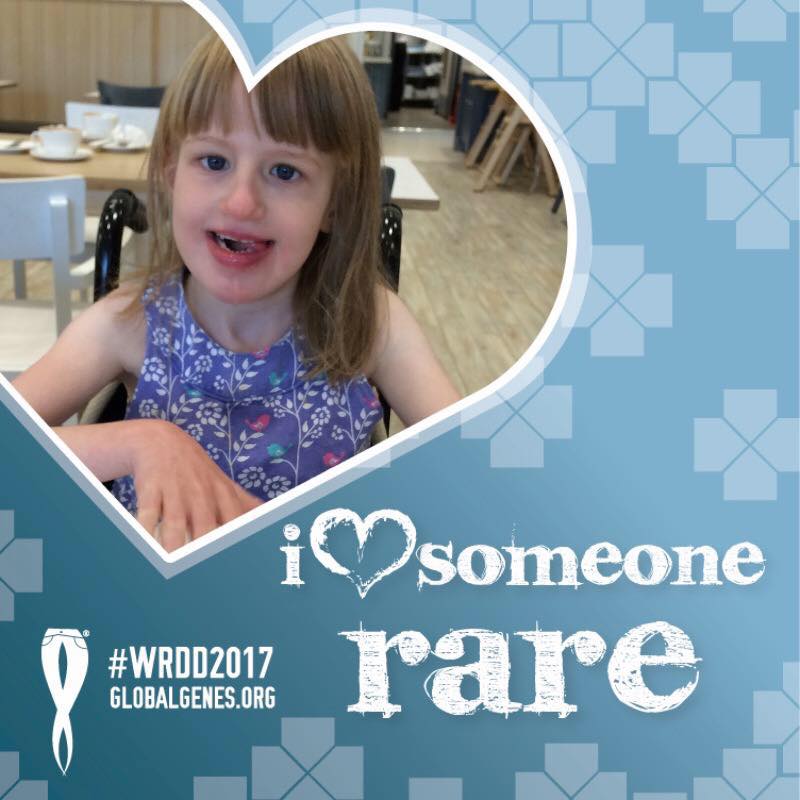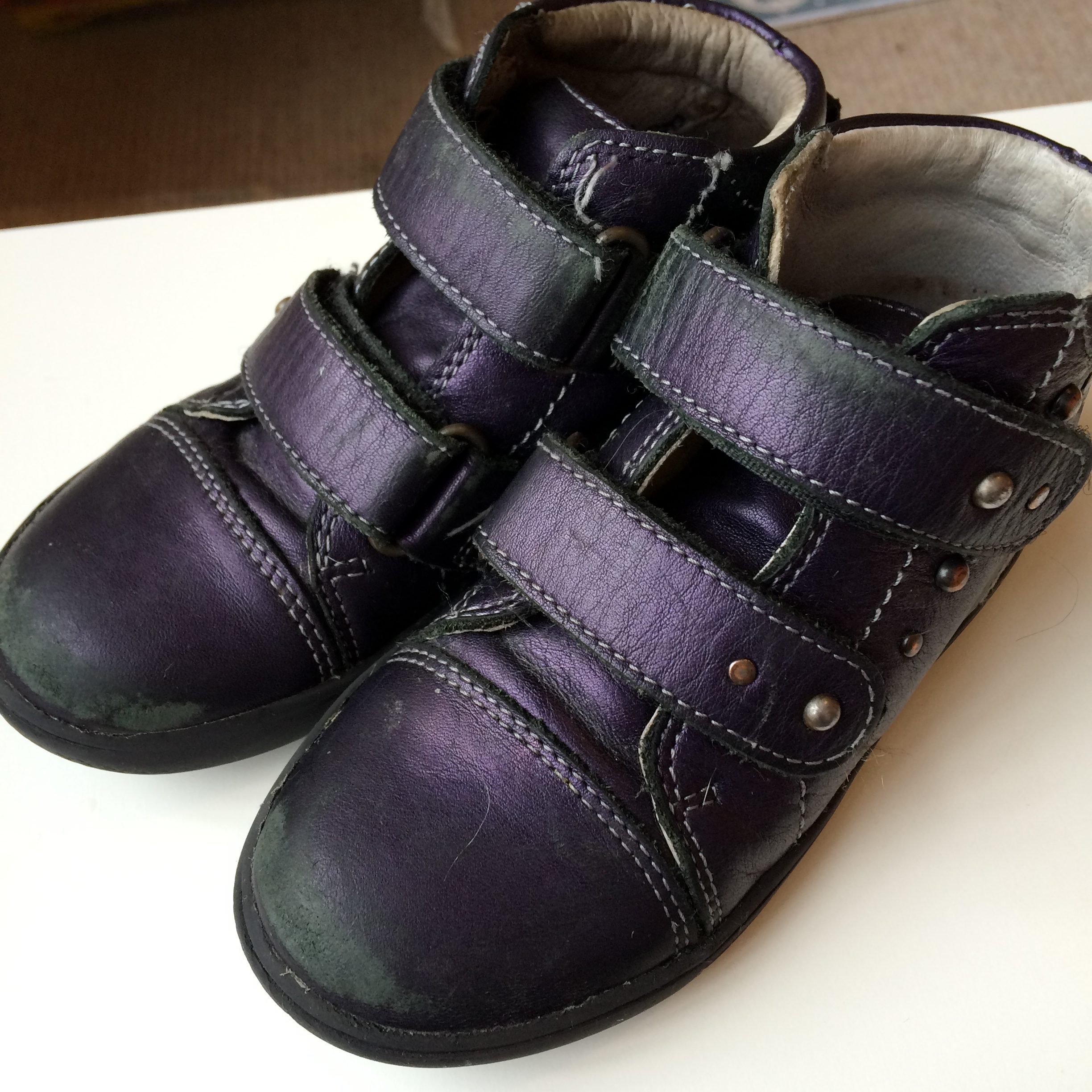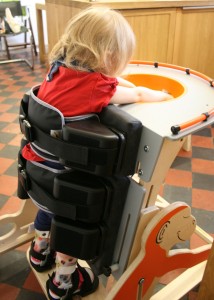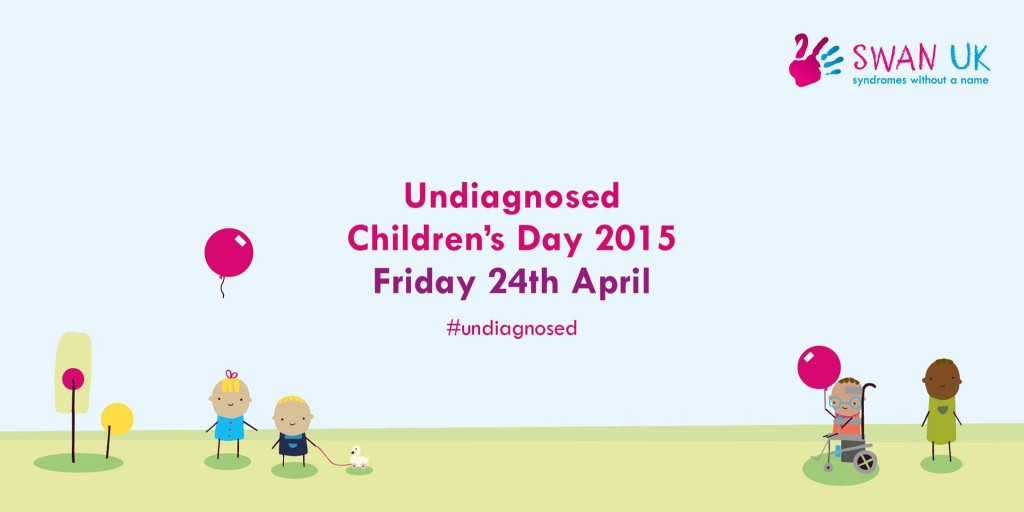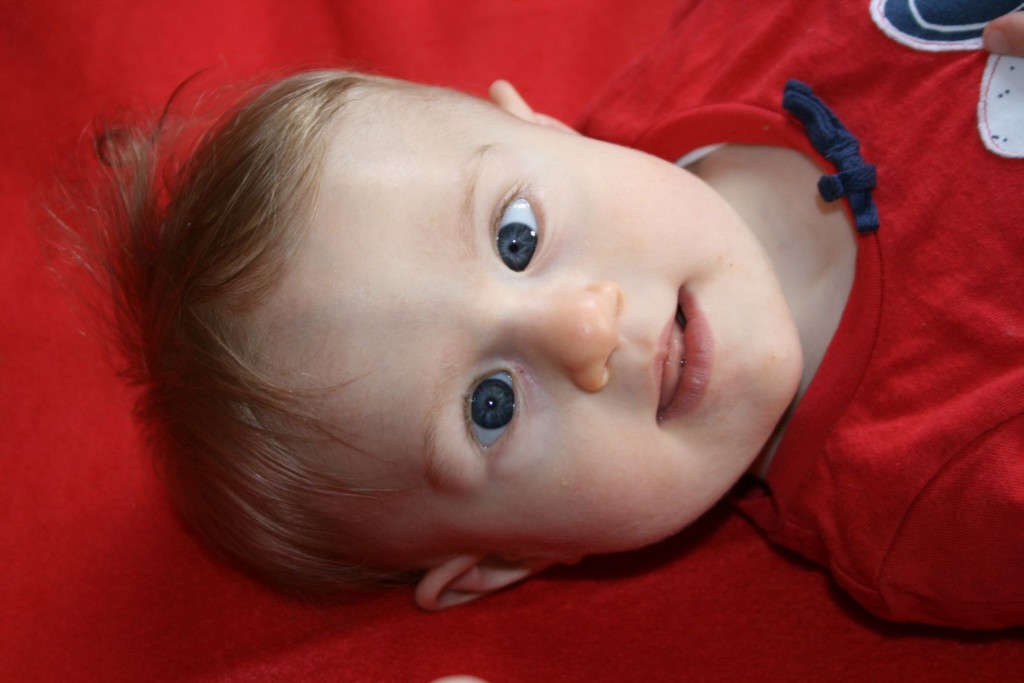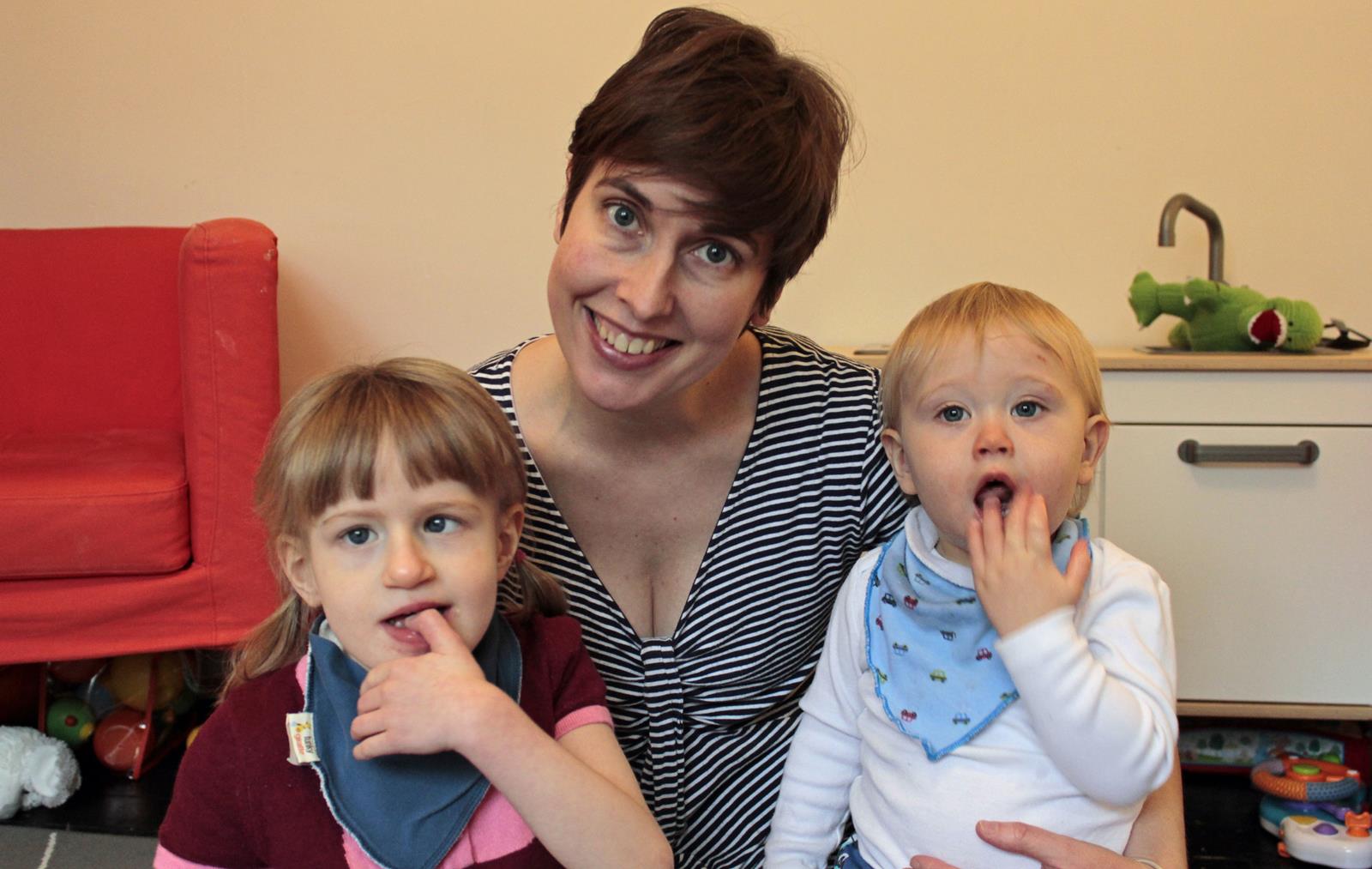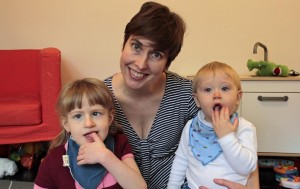2017 positivity
It’s so easy to get so absorbed in the nitty gritty of the day to day, that you can miss seeing all the little achievements and milestones that you’ve reached. 2017 was not all cupcakes and rainbows of course, but I thought I’d take a look back at some of the big the positives from the past year, and I’m pleasantly surprised at how much I wanted to try and fit into this post!
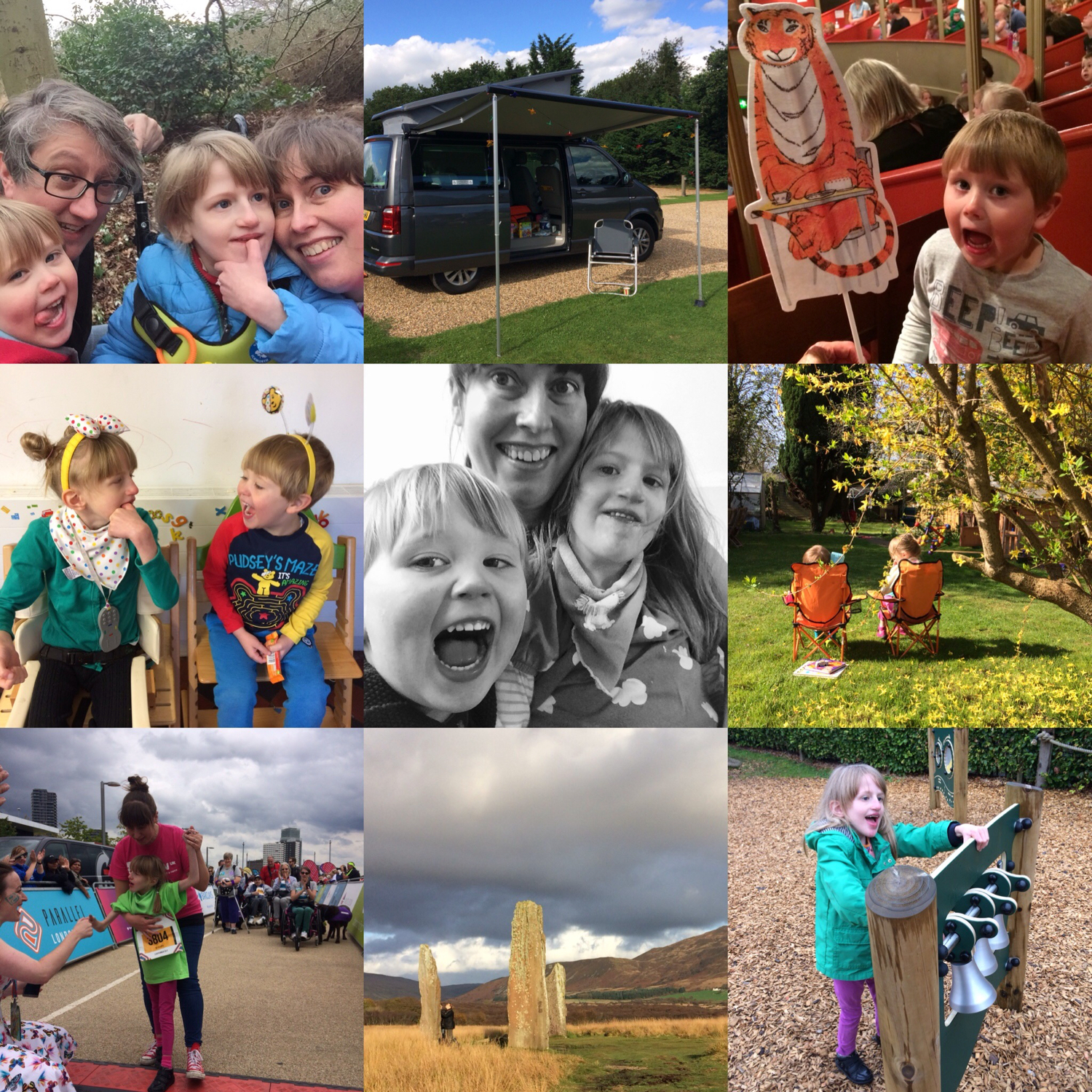
2017 started with a lot of talk about accessible toilets, thanks in the main to the amazing Anne Wafula Strike for speaking out about a horrible experience she had on the train.
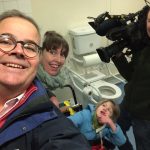 This media attention lead to our family being featured in a little film with our local BBC new channel, which I wrote about here, and throughout the year changing places toilets were in the news on various occasions, thanks to the clever ideas of fellow campaigners! Most recently Hadley’s Hero’s amazing #LooAdvent making The Last Leg and being featured on the Jeremy Vine show on BBC Radio 2!
This media attention lead to our family being featured in a little film with our local BBC new channel, which I wrote about here, and throughout the year changing places toilets were in the news on various occasions, thanks to the clever ideas of fellow campaigners! Most recently Hadley’s Hero’s amazing #LooAdvent making The Last Leg and being featured on the Jeremy Vine show on BBC Radio 2!
This year I’ve been trying to learn as much as I can about the origins of the changing places toilet standards, the research they’re based on, meeting various (official & unofficial!) campaigners and the processes for contributing to legislation changes.
This included contributing to a number of different government consultations, something I’ve never done before, but really interesting to have potential to help influence policy & standards! The main ones this year being an inquiry by the Women & Equalities Committee which enabled me to contribute to the discussion on both accessible housing and changing places toilets (my two favourite themes!) – I even got a little mention in both those sections of the Disability and the Built Environment Inquiry Report, so it was definitely worth doing!
The other main accessibility consultation of the year being on the draft of BS 8300, the British Standard document which deals with accessibility of the built environment. I’m afraid I was a little underwhelmed by the accessible toilets section and still feel that it reads as though some disabled people are Slightly Invisible when it comes to inclusion.
2017 saw us also actually encountering our first 3 (!) real life changing places toilets!: Grand Arcade multi-storey car park in Cambridge, Mid-Suffolk Leisure Centre in Stowmarket and Kirroughtree Visitor Centre in Galloway Forest Park – We actually travelled over an hour off our route home from Ayrshire to Cambridgeshire to visit Kirroughtree, as we wanted a family friendly car break, with facilities we could ALL use! Very exciting and liberating for us, but when I try and put it into context with how many toilets (that other people can use) that we may have encountered in all the other places we visited throughout the year (can’t even begin to count!?) it’s a little soul destroying that we are still where we are.
Another exciting dabble in how legislation works, was to find that my MP (Heidi Allen)’s amendment to the Neighbourhood Planning Bill regarding accessible housing had been adopted into the legislation! I had popped along to her surgery at the end of last year to ask about ways we could improve accessible housing provision and she had been really interested and pursued the idea, having previously met with Papworth Trust, and the following week was meeting Habinteg (both influential in accessible housing research and standards) – it was really interesting to see how these things unfold and although things could always be further reaching – I want to give a huge thanks to Heidi Allen for pushing accessible housing up the agenda in housing legislation!
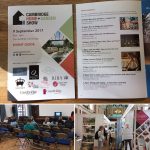 I also want to give a huge thanks to Jennifer of the Cambridge Home and Garden Show for being so supportive of the concept of inclusive design and featuring it within the first show of it’s kind in Cambridge! I’m not sure how good I job I managed to do (speaking is not really in my comfort zone!) but I gave a little talk about the benefits of inclusive design for everyone! I would love to be involved in the show again in the future, and may look towards taking a stand at this or other similar events to give advice to householders on how they could maximise the potential accessibility of their homes to make them welcoming to all of their family and friends!
I also want to give a huge thanks to Jennifer of the Cambridge Home and Garden Show for being so supportive of the concept of inclusive design and featuring it within the first show of it’s kind in Cambridge! I’m not sure how good I job I managed to do (speaking is not really in my comfort zone!) but I gave a little talk about the benefits of inclusive design for everyone! I would love to be involved in the show again in the future, and may look towards taking a stand at this or other similar events to give advice to householders on how they could maximise the potential accessibility of their homes to make them welcoming to all of their family and friends!
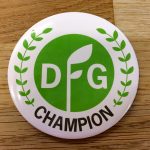 Another housing thing I went along to this year was a DFG Champions Roadshow, run by Foundations HIA, to help link up professionals keen to improve the DFG (Disabled Facilities Grant) process. It was interesting to see all the work going on behind the scenes and the efforts going on to improve things all the time. As someone slightly on the edge of the process it was really nice to be welcomed into the Champions, and my ideas and experiences welcome in the debate. Some of the info from the roadshow I attended, and the others that have been held can be viewed on the Foundations website.
Another housing thing I went along to this year was a DFG Champions Roadshow, run by Foundations HIA, to help link up professionals keen to improve the DFG (Disabled Facilities Grant) process. It was interesting to see all the work going on behind the scenes and the efforts going on to improve things all the time. As someone slightly on the edge of the process it was really nice to be welcomed into the Champions, and my ideas and experiences welcome in the debate. Some of the info from the roadshow I attended, and the others that have been held can be viewed on the Foundations website.
A massive surprise early last year was that I was nominated in the inaugural BAPs Awards, in the Campaigning For Change category! The awards ceremony (hosted by the fabulous Sally Phillips!) was a fantastic night and it was so lovely to meet so many amazing people all out there making the world a more understanding and inclusive place!
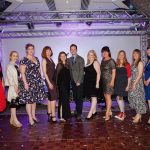
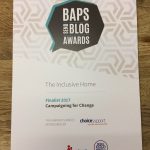
At the end of the summer, as a family, we attended Parallel London for the first time! It was awesome! A properly inclusive event and family festival! The motto for taking part in the races was, “start together, finish whenever”! We took part in the sensory 1K designed by the brilliant Joanna Grace (@jo3grace) and J and I walked the last 50m! It was extra touching that Joanna welcomed J over the finish line (see the bottom left image in best nine pic above)! Parallel London is definitely on our ‘things to do list’ again in 2018, I couldn’t recommend it enough!
In the summer we finally bit the bullet and decided to invest in a new car. A Wheelchair Accessible Vehicle (a WAV), but if we were going to buy get a bigger vehicle we decided to go the whole way and make it work for us in as many ways as possible…. so not just a WAV, but a CamperWAV! We’ve only managed to stay away one weekend in it so far, but have lots of adventures planned for this year, and it’s been invaluable for other reasons too! (Check out the CamperWAV tab above to find out more!)
And finally we had some amazing family experiences over the year, from lovely days out and holidays to milestones reached by my little lovelies! The biggest being J mastering pulling herself up to stand all by herself and the biggest for her little bro was finally braving putting his face in the water at swimming lessons!
So as we step into 2018, I’m looking forward to progress with my campaigning and lobbying for better accessible toilet standards & to reaching a wider audience with the concept of inclusive home design! We have finally had some concerted time to get our own ‘inclusive home’ plans back on track and hope to be able to get on with the actual construction work to our house in the Spring/Summer!
Here’s to a more inclusive and accessible 2018!
Happy New Year!
What’s in a name?
I’m a little late joining in with Mum on a Missions’ #SEND30DayChallenge but here goes…
Day 1: Meaning behind the blog name
This is a very apt theme as I’ve been intending to write a little bit about my blog name for ages!
It may be completely obvious, particularly to my regular readers, that I’d name my blog about inclusive design. Beginning our own home design/disabled adaptations journey was the inspiration for starting to write about accessible home design in the first place.
I considered various different names (when I was googling what was available!).
Things like AccessibleHouse and InclusiveDesign, but I kept coming back to InclusiveHome. It occurs to me now (if not then – I may be post rationalising!?) that my blog is not just about our house of bricks and mortar, but as much about our home life, our family.
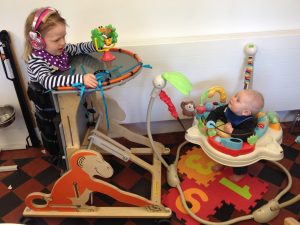 You might then wonder – wouldn’t having an inclusive home life go without saying?
You might then wonder – wouldn’t having an inclusive home life go without saying?
Well, actually no.
It’s really not that easy to lead an inclusive life! There are so many barriers outside your control that mess up access and natural inclusion, and even snooker your ability to try to enable inclusion. From the shortage of inclusive activities to the challenge of accessing public transport and the lack of the most basic facilities suitable for disabled people (like toilets!).
If you check out the social model of disability (the response to the medical model), the theory is that it’s not disability that isolates and excludes, it is society’s perspective of what a person should be (and be able to be) and the physical barriers in our environment that disables people, prevents inclusion and limits independence.
Creating an environment that is inclusive for everyone, is as much relevant to our inclusive home life as our house is, and so the scope of my blog expands…..!
SWAN UK is so much more than just a chat forum!
A post for Undiagnosed Children’s Day 2017
When J was born 6 years ago, our blissful newborn baby bubble was burst in a matter of days, by an echocardiogram, a skull x-ray and some chromosome blood tests before we even left the hospital. This was the beginning of a very confusing time and a long list of hospital appointments and tests, over many months and years, as each came back ‘in the normal range’, ‘clear’ or ‘negative’.
J’s main ‘symptoms’ (impossible to see in antenatal scans or in a newborn baby) are developmental and sensory disabilites, which gradually became more and more apparent as she grew older, but, especially as J was our first child, it was hard to tell if early symptoms (reflux, low muscle tone, heart murmur etc), were anything to be concerned about. As the tests seemed to say otherwise, we often felt like neurotic first time parents and, living in limbo, without a diagnosis felt very isolating. You can read a little bit more about that time in my post Monkeys & Swans
We felt like the only people in this position, and didn’t really feel like we fitted in regular parenting groups, but without a name for J’s condition, I didn’t know where to look for somewhere we would feel we belonged. If only I’d thought to google ‘Syndrome’s Without A Name’ or ‘Undiagnosed’ earlier in our journey as SWAN UK (Syndrome’s Without A Name), the only dedicated support network available in the UK for families of children with undiagnosed genetic conditions, was there all along!
We found SWAN UK just over 4 years ago, when J was a little over 2 years old and I can’t really explain how much of relief it was to find we were not alone. That there were people who ‘got it’. And that there were people we could turn to for advice and support. It truly was a lifeline of sorts.
I know Facebook has a bit of a bad press sometimes, and it can be a bit, ‘look at me and my perfect life‘, but it does also provide those who, for whatever reason, struggle to connect with others in real life a fantastic and easy to access medium to make those connections further afield.
SWAN was not my first dabble into support goups and internet forums. Before J and W came along, my husband and I went through an emotional few years of recurrent miscarriage and I found refuge in an amazing bunch of women in a miscarriage support forum on Babycentre website. Many of us have met up in real life and are still in touch now via Facebook. I guess it’s a similar scenario in that, although miscarriage is extremely common, people don’t really talk about it and you can feel so alone.
But what I also want to highlight today is that SWAN UK is not just another forum. Not just a webpage or a just a Facebook page. It’s all of those things, plus there’s so much more going on behind the scenes that help to support families like ours!
The main aims of SWAN UK are:
Develop and support a community of families of children affected by undiagnosed genetic conditions.
Support the development of high quality information and services for families of children affected by undiagnosed genetic conditions.
Raise public and professional awareness of undiagnosed genetic conditions and the unique challenges faced by affected families.
So what this looks like to me (and this is just me as a parent member, I know there’s lots more I don’t know!) is:
An amazingly supportive facebook group/forum with families from all across the UK! The group is really warm and friendly, and as it’s moderated by SWAN, and a host of volunteer parent reps, it’s not a group that suffers from confrontation or competitive parenting (like some other groups I’ve joined in the past and pretty quickly left again!). There’s usually someone around 24/7, so there’s pretty much always a listening ear. It’s a great place to come for advice, support and gentle ‘cyber’ hugs when you need them, as well as an place with encyclopaedic knowledge for asking totally practical advice such as types of equipment, filling out forms! There are also separate smaller regional groups, so people closer together can arrange informal meet ups and chat about specific issues in their areas. As well as allowing you to break the geographical barriers, another benefit of being online is that you can get involved as much, or as little, as you like, and are perhaps are more comfortable to speak openly with in a ‘virtual’ community than you’d be in real life. The groups are all ‘secret’ so membership cannot be searched for by anyone not in the group either, so you have anonymity if you want or need it.
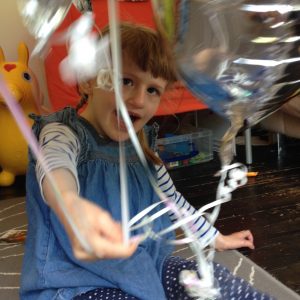 In addition to the forums, SWAN also organise and fund lots of family get togethers throughout the country! We’ve been to the zoo, a maize maze, to a soft play party and on a train ride over the time we’ve been members! I’ve loved meeting some of the other localish families in real life, lovely to meet the children, and them to meet each other, and I think as W grows older, meeting the siblings of other undiagnosed children will also become really important for him.
In addition to the forums, SWAN also organise and fund lots of family get togethers throughout the country! We’ve been to the zoo, a maize maze, to a soft play party and on a train ride over the time we’ve been members! I’ve loved meeting some of the other localish families in real life, lovely to meet the children, and them to meet each other, and I think as W grows older, meeting the siblings of other undiagnosed children will also become really important for him.
Balloons! This may sound a bit superficial, but I can’t tell you how lovely it is to receive a lovely gift of balloons, knowing our SWAN family is thinking of us and providing lots of fun! Who doesn’t love a balloon!? SWAN try to send balloons out to children in hospital, going through a particularly rough time and occasionally randomly just to make a child smile! As you can see in the picture, the balloons we received went down very well!
SWAN UK do a lot of work with professionals too, to raise awareness within the disciplines that families will come into contact with on their childhood journey, from Midwives and Health Visitors to GPs and NHS decision makers about the added complexities families face without a diagnosis, and pressing for better co-ordinateion of health care and social care. Some key successes they’ve been integral in, in this area are the appointment of a specialist undiagnosed nurse specialist at Great Ormond Street and a specialist Rare Disease unit at Birmingham Children’s Hospital!
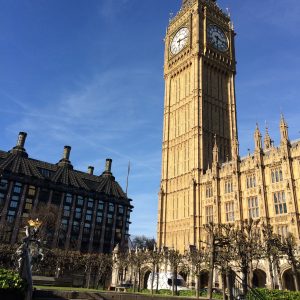 SWAN UK, and their parent organisation Genetic Alliance, are also working with the government on policy around research, resources, services, treatment etc of rare genetic and undiagnosed conditions. Genetics is such a new and fast moving science there’s so much happening that could make such a difference! I got to see a little bit of this work first hand last year, when SWAN UK parent reps and bloggers were invited to attend the first report of a new APPG (All Party Parliamentary Group)! So amazing to see Genetic Alliance and SWAN influencing at all levels to help improve services for our families and really interesting to see parliament at work too!
SWAN UK, and their parent organisation Genetic Alliance, are also working with the government on policy around research, resources, services, treatment etc of rare genetic and undiagnosed conditions. Genetics is such a new and fast moving science there’s so much happening that could make such a difference! I got to see a little bit of this work first hand last year, when SWAN UK parent reps and bloggers were invited to attend the first report of a new APPG (All Party Parliamentary Group)! So amazing to see Genetic Alliance and SWAN influencing at all levels to help improve services for our families and really interesting to see parliament at work too!
So the reason I’m writing this today is it’s Undiagnosed Children’s Day! A day to make a group effort to let the world know about the work SWAN UK do! They already support 2000 families of children with undiagnosed conditions but, as 6000 children are born every year with no diagnosis, there are many more they could be supporting!
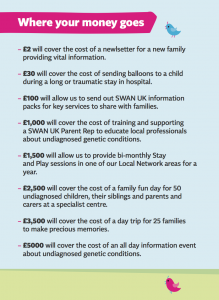 SWAN UK are asking us to be detectives today and help find those families (like ours) who could benefit! Help us spread the word!
SWAN UK are asking us to be detectives today and help find those families (like ours) who could benefit! Help us spread the word!
If you know someone you think might benefit from joining the swan community please do pass this on, and if you have a child with an undiagnosed condition please do join the community! It may sound overly gushy, but SWAN UK really is like a big friendly (and non-judgemental!) family and I don’t know where we’d be without their support! You can sit in the background quietly, or get stuck into chat in the forum, either way SWAN is there to support you and they are out their advocating for all of us!
SWAN UK relies on grant funding and donations and this list shows where some of this money is needed. If you can please help them keep up the great work for families like ours!
Find SWAN at:
Website: www.undiagnosed.org.uk
Email: info@undiagnosed.org.uk
Facebook: @SWANchildrenUK
Twitter: @SWAN_UK
Instagram: SWANchildrenUK
Rare but not alone
We are members of SWAN UK, a fantastic support network for families of children without an overarching diagnosis for their medical conditions and/or disabilities, support for families of those with a Syndrome Without A Name.
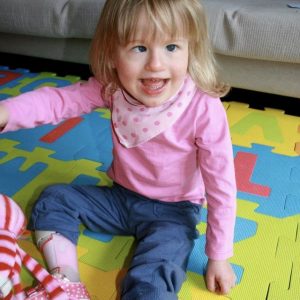
We didn’t find SWAN (run by the charity Genetic Alliance) until EJ was 2 years old, when we found a leaflet in our enrolment pack for the DDD study. Until this point all the standard NHS genetic tests available had drawn a blank in identifying any particular reason for her developmental delays and we had felt pretty confused and alone. (You can read a bit more about this uncertain time here and here.)
The DDD (Deciphering Developmental Disorders) study is a far more detailed method for genetic testing than the NHS can offer (which coincidentally is being carried out just down the road from us at the Sanger Institute in Cambridge!), using new technologies to try to identify particular gene changes responsible for developmental disorders.
“Instead of having a targeted test for a particular change, we therefore have to look across all of the child’s genome to find out if and where a change occurred which caused the disorder” – www.ddduk.org
This analysis of the whole genome can take some time…..
…. and in the meantime we have become quite comfortable being part of our big ‘SWAN’ family. We’ve found help, advice, comfort, true friends and love in our extremely diverse community, and have celebrated Undiagnosed Children’s Day at the end of April each of the 4 years since we joined.
However this year is a little different.
And I’m actually writing this particular post to coincide with another awareness day, Rare Disease Day, because (quite out of the blue as we’d almost given up hearing anything at all!) we received a letter via EJ’s geniticist that the DDD study has found a gene change that is the probable cause of EJ’s disabilities! So, quite unexpectedly EJ may have become a ‘graduate’ SWAN (although I am relieved to say that graduate SWAN families are most welcome to remain part of the big SWAN family – phew!)!
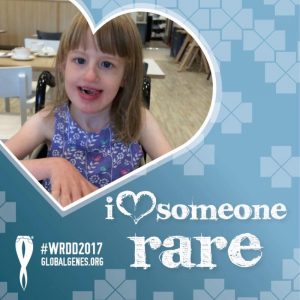 Of course you are always advised to steer clear of Dr Google, but when it’s been 5 years since investigations began, you kind of can’t not google!? And also, when you are dealing with something so rare, and so new, there’s almost as much information out there in the hands of Dr Google as there is available to the medical professionals (granted I’m not quite as qualified to interpret it all as the real doctors!)!
Of course you are always advised to steer clear of Dr Google, but when it’s been 5 years since investigations began, you kind of can’t not google!? And also, when you are dealing with something so rare, and so new, there’s almost as much information out there in the hands of Dr Google as there is available to the medical professionals (granted I’m not quite as qualified to interpret it all as the real doctors!)!
I’m not sure if there is a right way to give a family a diagnosis, especially such a long awaited one. I’m not even sure if this counts as a diagnosis as such? Too fledgling a discovery even to have a name, other than the gene name, KAT6A. We were told via letter, which may sound a bit blunt to some, but I think I would have worried myself silly having received a more cryptic letter asking us to attend an appointment at a later date, or a telephone call, which always seem to come at an awkward time.
I think it probably depends on the news.
The information we were given was not frightening to us. Internet searches of EJ’s gene glitch brings up almost an exact list of the symptoms we already knew about for her. I think if there had been more worrying symptoms listed I might feel differently, and perhaps the news would have been delivered differently?
After Dr Google, our next move was to check Facebook to see if there were any other families out there, and, lo and behold! There are! So far, around 70 (mostly children) all across the world, including a few others in the UK, who have disabilities almost exactly like EJ! Some of the families have even gathered together the information known about the KAT6A gene change on this new website!
I’m not yet sure how much difference having this information will make. In some ways a relief? We may learn some useful things through research into the gene change… issues around health? Perhaps improved strategies to help EJ reach her potential?
However the loveliest thing about the diagnosis so far is finding those other families, and also discovering some of the ‘behavioural traits’ linked to the condition are ones that we know & love!….
A happy demeanour! Always smiling, loving cuddles, giggling and laughing often!
And so it seems we are embarking on another stage of our journey….. but always thankful to have our SWAN family travelling with us!
My #TravelStories
(In response to the ‘Greater Cambridge City Deal’)
I’ve never commuted by car.
In my working life, I actually enjoyed my morning commute by train or tube (when I lived in London), and underground (when I studied in Glasgow), allowing me time to get stuck in to a good book or listen to my ipod – yeah, ok, not always, I certainly don’t miss having someone’s armpit in my face!
I’ve also enjoyed commuting by bike in London and in Cambridge. I love cycling and it’s by far my favourite mode of transport, IF the infrastructure is there (otherwise it’s a wholly stressful experience!), if the distances allow and IF you are able to!
I’ve always found buses stressful. Possibly my own anxiety issues? They seem less predictable than train/tube/tram, the time is harder to judge and I’m always anxious I’ll miss, or not recognise, my stop. I’m a bit (actually, a lot) of a map geek and I guess I like the clarity of trains and tubes. In fact I’d describe both me and my husband as map/transport geeks! It seems perfectly natural to us to have selected each of our homes together based on the transport links, train lines and cycle routes!
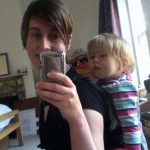 When EJ was small, public transport was still easily doable. I didn’t attempt the faff with the pram/pushchair as I had a baby carrier for walking the dogs, so I used it most of the rest of the time too. EJ’s always been light for her age so I carried on in that way pretty much until she got her prescribed specialist buggy from wheelchair services, which coincided with her brother arriving, and her starting nursery in a neigbouring (awkward to get to by public transport) village. It was at that stage I began to use the car a lot more.
When EJ was small, public transport was still easily doable. I didn’t attempt the faff with the pram/pushchair as I had a baby carrier for walking the dogs, so I used it most of the rest of the time too. EJ’s always been light for her age so I carried on in that way pretty much until she got her prescribed specialist buggy from wheelchair services, which coincided with her brother arriving, and her starting nursery in a neigbouring (awkward to get to by public transport) village. It was at that stage I began to use the car a lot more.
As I say, I love cycling and we are a cycling family so we do have a selection of bikes/accessories to enable us to carry on pedalling, including a fantastic family trike (zigo leader) which has a detachable front pod that can be used as a buggy. As EJ is a wheelchair user, we can’t just cycle somewhere without having a mobility aid at the destination!
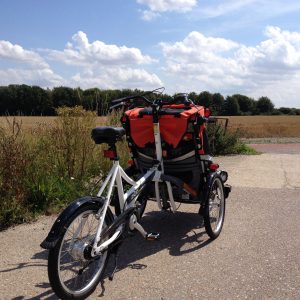 However there are limits to how much and how far we can cycle, physically (I’m pretty exhausted generally through lack of sleep and I do a lot of lifting and carrying in my role as carer) and also the time I feel is reasonable to expect the kids to be strapped into bike seats.
However there are limits to how much and how far we can cycle, physically (I’m pretty exhausted generally through lack of sleep and I do a lot of lifting and carrying in my role as carer) and also the time I feel is reasonable to expect the kids to be strapped into bike seats.
Public transport, on my own, at rush hour, with wheelchair and two children… no…. just, no.
I don’t mind driving from time to time and in many situations I now find it necessary (to take the kids to different destinations. To transport the dogs, shopping, wheelchairs, walking frames….).
However I now find myself commuting by car. And I hate commuting by car.
EJ has just started Year 1 at special school. It is 6.9 miles from home (so google tells me). The next closest school (and, apparently, officially her catchment school, although I have never found or been supplied with any documentation to confirm this) is 8.5 miles from home. We have not been allocated school transport. With EJ less than 6 years old, I don’t think I would be taking up school transport even if we were offered it, I’m not ready, EJ is still my baby girl and it’s something I’ll investigate further later down the line. In the meantime I’ll take my little girl to school myself, like I would do if she was at mainstream school. However as she’s not at mainstream school that (normal parental job – the school run) involves a 6.9 miles journey at rush hour. So we drive. It takes us at least 40 minutes there and then about 20 minutes home, which is a long time in the car, but I feel most guilty for my almost 3 year old being stuck in the car all that time. (And of course then there’s the school pick up later in the day, so in total it’s 27.6 miles/day.)
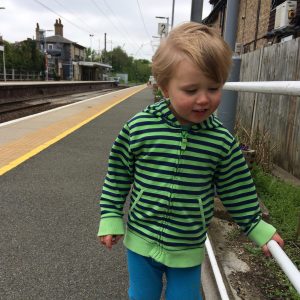 Once or twice a week my husband is able to drop EJ at school on the way to work, leaving the car close to school. The wee guy and I will then make our way into town by public transport, which involves at least one change and generally a longish walk, depending on the route we choose. Thankfully EW is a bit of a train fanatic so he loves that part of the journey (however if more parking restrictions come into force this may no longer be possible for us, as we can’t afford the cost of high car parking charges on top of all our travel costs).
Once or twice a week my husband is able to drop EJ at school on the way to work, leaving the car close to school. The wee guy and I will then make our way into town by public transport, which involves at least one change and generally a longish walk, depending on the route we choose. Thankfully EW is a bit of a train fanatic so he loves that part of the journey (however if more parking restrictions come into force this may no longer be possible for us, as we can’t afford the cost of high car parking charges on top of all our travel costs).
The current ‘City Deal’ proposals for Cambridge are a real worry for our family and I know they are for many others too.
I don’t feel we have any viable alternative to the car – I would LOVE if we did. The proposed congestion control points will impact directly on our current route. We will have to change to a longer way round, along with everyone else, so not only will the distance increase, it will also become busier. Our journey WILL take longer.
I don’t have the answers. I totally understand this is an extremely complex puzzle, but it seems to me that if you make driving awful for the average commuter (the ones you are trying to encourage onto public transport), you also make it awful for everyone else, including those who have no other viable options.
Us. Other disabled people. Carers and community services, local residents and local business to name a few that spring to mind.
I think there have already been a few contradictory strategic decisions in the city. Introducing charging for car parking at the park and ride, for example, seems to me to be counter to encouraging people onto the bus or cycling from those out of town locations! Positive reinforcement works for kids (and dogs! 🙂 ), perhaps it does for commuters too! Wouldn’t it be better to be offering incentives/rewards for ‘good behaviour’ rather than punishing the ‘bad’!
In our ‘special needs world’, there was a county decision a decade or so ago to consolidate the special schools into a fewer number of better equipped schools. Great in many ways as we love EJ’s school! However it means kids have to travel further distances and most of them have to be driven to school (either by bus, taxi or private car), and at least some of the staff need to drive as they also have community support roles to fulfil, so it’s inevitable that there will be traffic trying to get to the school at morning rush hour.
My feeling is that if you make public transport and cycling the most attractive option for the fit and able individual commuters, you have a far better chance of striking a natural balance between car use and more sustainable forms of transport.
Make the cycling infrastructure truly integrated (on my route into the city centre there are still many hairy sections and tricky junctions).
Improve public transport. We’ve yet to see how the new Cambridge North station might improve congestion, and I know there are proposals for another new rail station at Addenbrookes in the South of the city. Perhaps there are other options too, for additional suburban stations on other lines into Cambridge? How about a station in Cherry Hinton/ Fulbourn on the Ipswich line for example?
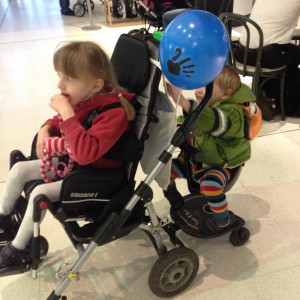
So this is my tuppence worth on the Cambridge congestion problem.
I know something has to be done, it really does, but to make sure some of our #TravelStories don’t get even worse, please think about the non typical commuters and the people living/schooling in the the midst of the congestion zone too.
Please think about those who who have little or no choice but to drive.
Let’s stop obsessing about shoes!
EJ is delighted to get back to school after the summer holidays! She has no formal communication (or at least not that we understand……yet!?) but it was clear from the excited bouncing in her chair and her lovely big grin that she knew exactly where she was and was raring to get back to a routine, fun activities and way more stimulation than I’ve managed to provide here at home! She loves school!
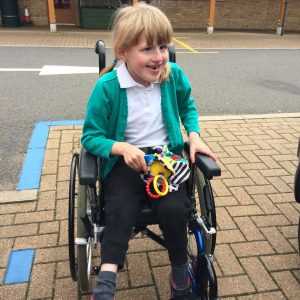 EJ is now in Year 1 at a special school. Eighteen months ago we agonised over the decision on which school would be best for her. Where possible I’d always choose inclusion. However on visiting several schools, including our lovely mainstream village schools and several special schools we could see straight away that her school would be the perfect fit!
EJ is now in Year 1 at a special school. Eighteen months ago we agonised over the decision on which school would be best for her. Where possible I’d always choose inclusion. However on visiting several schools, including our lovely mainstream village schools and several special schools we could see straight away that her school would be the perfect fit!
EJ’s school has a uniform. I like the idea of school uniform. It gives a sense of identity and belonging to the children, and makes organising an outfit in the morning so much easier for me! EJ’s uniform is a nice balance of comfort and practicality and (I think) as smart as a school kid ever really needs to be. Soft polo shirts, sweatshirt or cardigan and trousers (which in EJ’s case are generally jersey fabric or leggings). They have an official branded clothing, or you can wear regular shop bought items in the school colours. I guess at a special school they have to be pretty relaxed. The children have such a variety of disabilities, sensory needs and medical conditions that clothing has to be comfortable and adaptable for school activities and to allow for independent and assisted personal care.
The same goes for shoes, black is the generally preferred colour, but as long as the shoes are practical for school activities we’ve found the school are happy, which for EJ is just as well as we struggle to find the right shoes for her in any colour!
Last year, when EJ was starting reception, I scoured the shoe shops and trawled the internet looking for suitable black shoes. EJ used to wear AFOs (Ankle Foot Orthosis), splints, which made finding shoes pretty tricky. The best we found were double velcro fastening sandshoes which allowed you to open the shoe right up to get the base of the splint into the shoe. She now has orthotic insoles which raise her heel slightly within the shoe, so for this reason, and to give her some ankle support, she needs to wear ankle boots, preferably with two velcro straps to get the insole into the shoe correctly and obtain a good fit around her ankle. EJ also has very small, and very the narrow feet (off the Clarks chart narrow!).
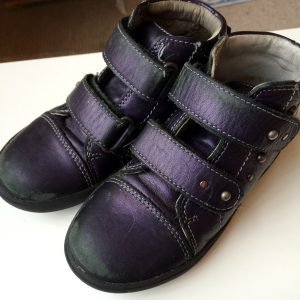 The best we could do last year was dark pearlised purple boots and she has started this term in navy and pink sandals! (Incase anyone reading has the same sort of shoe fit issues as EJ, the brands we have found that work best for EJ are Ricosta and Richter – neither of which are cheap!)
The best we could do last year was dark pearlised purple boots and she has started this term in navy and pink sandals! (Incase anyone reading has the same sort of shoe fit issues as EJ, the brands we have found that work best for EJ are Ricosta and Richter – neither of which are cheap!)
This is probably a whole other post (rant), but the “girls” school shoes selection is flooded with pumps, mary jane and the occasional brogue style shoe. Next to nothing with any ankle support. Surely it’s not just children with “official” orthopaedic issues that would benefit from ankle supportive shoes? I’ve seen a few options in the “boys” selections (although still not many in the school styles), and although I’m not swayed by the girl/boy marketing, the problem is boys styles are always wider fit, and just don’t fit EJ. I’m very excited to have come across one black ankle boot this year online from mainstream brand Startrite, so I’ve ordered them today and I hope they will be narrow enough (they do have some patent leather detailing and some decoration though, so I’m not sure if they would pass a strict school uniform test…!).
So what if circumstances had been a little different, if EJ’s academic learning was more consistent with a mainstream approach and we had chosen to send her to a mainstream school?
It made me really sad to read various stories in the news (like this one in the Guardian) about various state schools sending kids home for not wearing exactly the right clothes or shoes. As I say, I like the idea of a uniform, but I don’t understand why it would need to be so strict that kids can’t wear something comfortable?
Lots of the comments on these articles made me equally as sad, things like:
- “Kids need to learn about sticking to rules”!
But our kids aren’t in the army! They are learning all sorts of things at school, rules of all different kinds, their lives timetabled from the age of 5, why does a specific sort of trouser fabric or shoe style need to be a part of that? Some kids like to challenge rules too. Conformity isn’t the only right way, seeing things differently, being creative can be a valuable asset in life and work! Why get bogged down in a stand off about shoes when you could be supporting the next generation of great innovators!?
- “Kids need to learn about the real world. I don’t have a choice about my work uniform”
Well, (1) that’s just one small aspect of the real world and work uniforms aren’t worn in all jobs and (2) most people do have some sort of choice in that, it’s part of the deal of that job contract. Kids at school don’t have a choice, they have to go to school and, until 6th form, that school was was most likely chosen for them by their parents or the Local Authority!
For several reasons I think an overly strict school uniform can be exclusive, rather than inclusive and levelling (the very reasons generally cited for having a uniform in the first place):
1. Sensory issues
Many kids have tactile sensory issues, sensory processing issues, ASD…. and have aversions to particular clothing (labels, stiff collars, scratch fabric, waistbands, restrictive shoes….). Children constantly distracted by their clothes are not going to be able to focus properly. Isn’t it more important to make sure our kids are ready and receptive to learn to the best of their abilities than obsess over the specifics of what they are wearing?
2. Physical
The traditional school uniform is just not practical for many children with physical impairments. Long skirts, stiff waistbands, stiff collar and tie, blazer. In EJ’s case, she spends much of her day in her wheelchair or using mobility aids. She needs help with personal care and help to transfer from her chair, either with adult support to stand or using a hoist. She wears stretch fabric trousers, elastic waistbands and loose polo shirts so that she’s comfortable. Flexible clothing also makes dressing and undressing easier, currently for the adults assisting her, but in the future easier for her to do independently.
3. Highlighting difference
Some comments on these school uniform articles highlighting the issues for children with special needs and disabilities, were countered with replies like “oh, well that’s different, I’m sure the school would make exception” – I think this is the attitude that makes me most uncomfortable! Disabled children, and children with other differences from their contemporaries, are already singled out, maybe visibly so or by a hidden condition (a learning disability, sensory issue, gender dysmorphia….). All kids have enough going on trying to feel part of their school community without a big flashing arrow pointing them out as an exception. Do they really need to be made to stand out more because they can’t wear clothing or shoes that don’t match the strict regularity of their contemporaries? Perhaps even making the other kids resent them. Will some kids just go along with the ‘rules’ in order to try and fit in, and as a result be uncomfortable and distracted throughout their school day? How will that help their learning? And what of those who don’t have an “official’ diagnosis? Those who’re just fidgety and uncomfortable being restricted in shirt and tie, why shouldn’t they get to wear something more comfortable?
If we really want the uniform to act as an visible leveller then shouldn’t all kids be given the same flexibility?
I guess this is a request to all schools to think about how their policies affect ALL kids (and also to retailers to provide uniforms for all needs too – especially supportive shoes for girls!) and to think about making their school uniform policy inclusive, as a small step in helping make the school community and therefore future society more inclusive.
slipping through the cracks
A post for Undiagnosed Children’s Day, 29th April 2016….
The very nature of an undiagnosed condition (a Syndrome Without A Name) is that it is not the same as any other that’s been identified.
Of course, every single one of us is different (whether deemed to have any physical or mental health condition, disability or not). And people who are diagnosed with a syndrome can be affected by it in very different ways (in the case of rare disease there may be very little known about the condition at all!), so diagnosis rarely gives a full picture.
And perhaps there are disadvantages to being ‘labelled’? Largely around preconceptions and conclusions that are leapt to about how YOU may be affected – when in reality there’s likely to be a huge variation from person to person.
However there are advantages in diagnosis too, which I’d say outweigh the disadvantages no matter how rare the condition, not least because it can help to stop you slipping through the cracks.
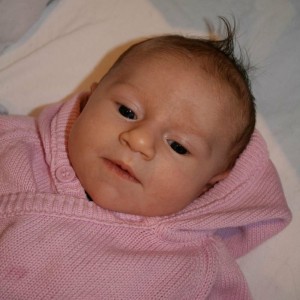 My antenatal tests gave no indications that EJ would be anything other than ‘a normal healthy baby girl’ – a commonly used phrase, and one that pregnant women are so eager to hear.
My antenatal tests gave no indications that EJ would be anything other than ‘a normal healthy baby girl’ – a commonly used phrase, and one that pregnant women are so eager to hear.
In the past perhaps I hadn’t really considered the implications of the phrase, how it separates ‘normal’ from, from what? abnormal? different? unique?!
As a phrase it now it tends to make me wince, because….
What is ‘normal’?
Indeed, what is ‘healthy’!?
When EJ was born, a few ‘issues’ rang some bells with the neonatal paediatrician and he ordered chromosomal blood tests while we were on the maternity ward. These came back ‘within the normal range’ so we were sent home reassured there was nothing ‘wrong’ with our new little baby bundle.
I can totally see how at this stage, with no evidence to suggest EJ wasn’t going to follow the typical child development path, it wouldn’t necessarily have been appropriate (or indeed helpful!) to launch into the full complexity of genetics and confuse a couple of tired and anxious new parents. However there was obviously in inkling there…..
…..and very gradually EJ began to collect more symptoms, including missing most of the typical development milestones, and her differences became more & more noticeable the older she got, and she began to stand out from the baby crowd.
The added complexity for us was that we moved NHS trust when EJ was 6 months old, so we had to start afresh with a new set of health professionals. Our GP notes of course would follow, but not instantly, and apparently notes and test results from hospitals don’t, they have to be requested specifically!
Thankfully we found our new GP surgery to be fantastically supportive and EJ was referred to our new hospital without fuss.
We then embarked on a very confusing journey of test after test, normal results, clear scans and more normal results. Being passed from one department to another, in and out of hospital clinics and community services.
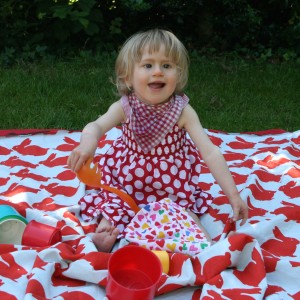
EJs symptoms (even her heart defect) could be related to ‘normal’ paediatric issues, so rather than being joined up, as they would more likely have been had she been diagnosed, were left feeling confused, even neurotic and paranoid about reading too much into things. We didn’t really know what questions to ask or even who to ask…..
We were also left feeling guilty and worried that perhaps we had done something wrong? Being asked by every new clinic the same questions about her history, even going over and over how my pregnancy had gone – did I drink or smoke or take drugs in pregnancy? – is all pretty guilt inducing! We’ve even been asked several times if me and her dad are related! – I know these questions have to be asked, but perhaps once is enough….? Perhaps a clear crib sheet at the front of medical notes!?
And all the while (we had a lot to take in, so unless things were spelled out it may have washed over us!) I don’t remember anybody saying (given her symptoms) that it was pretty likely that EJ did have some form genetic disorder no matter what the results of the tests. In fact I’m not even sure how many of the non medical professionals involved were aware that living with an undiagnosed condition is such a common state of being, sometimes not just a stage while you wait for meaningful test results (6000 children a year are born with an undiagnosed condition!)….I’d even hazard a guess that some may have suspected it was all in our minds…. as they (like us!), would have expected something to have come up in some of the tests EJ’d had.
The health, social care and early years education system can be complicated and confusing enough for anyone, but I think where having a child with an undiagnosed condition differs from those with known syndromes, even rare ones, is that without a ‘name’ you feel like you are constantly trying to convince people that there really is ‘a thing’. Whether that’s a thing (as for EJ) affecting her sensory processing and in turn her development, or a thing linking a group of medical problems together. Many, like us, feel isolated, perhaps not feeling like you qualify to join ‘additional’ needs groups (but can’t relate properly with mainstream), don’t qualify for help, and that perhaps you are a fraud for taking up valuable NHS time?!
Many undiagnosed children have extremely complex medical needs, many from birth or even before they were born, so unlike EJ will have been ‘in the system’ from the beginning – but, from what I understand, this doesn’t necessarily mean care is better co-ordinated. For many, one medical symptom will dominate, and that medical specialty might take the lead in fire-fighting that need, but they are not necessarily the right team to be investigating the cause and leading on the overall care of the child.
I really don’t mean any of this to sound critical of any of the individual people, teams or clinics involved, or indeed the NHS or social care. Far from it! Overall we have had wonderful care! We really do understand the massive strain and funding constraints on the NHS and social care, and the limitations of working within a framework of approved techniques, medications and therapies. However that’s not to say there couldn’t be big improvements in coordination of the care, particularly for patients with undiagnosed conditions. More coordination could also bring more efficiency (and less frustration!) for all involved, freeing up those in the caring and medical roles to ditch some of the admin and get on with what they want to do, providing support, treatment, therapy etc
With many known syndromes there are often typical symptoms and treatments, and you’d be put in touch with key teams, relevant tests carried out and early intervention therapies begun from the start with a coordinating specialist overseeing the care.
With a rare condition a plan is less likely to be in place, but at least there is a focus, something tangible even if still confusing. There is likely to be medical research going on, some interested specialists (which can never be the case for undiagnosed patients as they are all so different, we are all hanging around hoping to grasp at the coat tails of some identified condition).
Being diagnosed also gives you the opportunity to meet and engage with other families in a similar position, however few of them there are. It’s such a human need to be able to share experiences with others who understand – which is why SWAN UK is so important to us undiagnosed families, because although we are all so very different, we do share challenges and the confusion of the unknown.
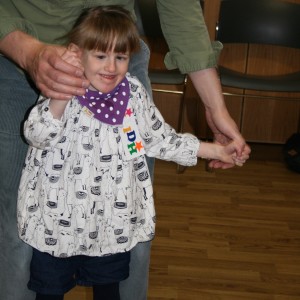
EJ’s long list of symptoms don’t really help give a full picture of her condition since they can be attributed to many other known syndromes and ‘normal childhood issues’ which means that we don’t know what the future might hold. In many ways I find this liberating, as there are no preconceptions about what her life and achievements will be. However it also raises difficult questions – Will she walk (what adaptations will we need to make in our home)? Will she talk (will we ever be able to communicate)? Will she be able to live independently (how much support or not will she need – what happens when me and her dad are gone!?)? Will she develop any associated health problems? Will she have a shorter life expectancy (actually I don’t think I want to know the answer to this last question!)!!!?
Genetics is just so bloomin’ complicated! We’re just at the tip of the iceberg in this area of medical research and, in the meantime, a long way to go to make sure it is acknowledged across the board that even if the tests don’t find an answer, it doesn’t mean there’s not a genetic glitch hiding somewhere, and that the family affected still needs the same level of help, support, treatment and therapies as those who are diagnosed with known conditions.
Last Undiagnosed Children’s Day a very exciting announcement was made for a new Roald Dahl SWAN nurse post at Great Ormond Street Hospital (there’s a great clip on this link of an interview with the super campaigner behind Just Bring The Chocolate about the new position). And also since then two new specialist nurse positions at Birmingham children’s hospital for a rare disease specialist nurse and a genetics specialist nurse! We in the SWAN community are holding our breath hoping these new roles will show the NHS just how much of a difference these coordinating speciast roles can make – and hoping they can be replicated at all the children’s hospitals and major teaching hospitals….. no pressure new recruits!
In parallel it’s so important that awareness is spread generally, and among frontline professionals that will come into contact with new parents (midwifes, health visitors, SENCos etc), that being undiagnosed is actually a ‘thing’ and that there is help and support out there in the form of SWAN UK!
This blog post forms part of an amazing series by SWAN parent bloggers for Undiagnosed Children’s Day 2016. Check them out via the blog hop link below!
And if you can, please support the work of SWAN UK via their website
there’s a lot we don’t know about genetics!
(An open letter to Heidi Allen MP & Daniel Zeichner MP)
Dear Heidi Allen & Daniel Zeichner
All party parliamentary group on rare, genetic and undiagnosed conditions
Today I’m joining with a group of bloggers to write to our MPs to ask them to join the All Party Parliamentary Group (APPG) on rare, genetic and undiagnosed conditions.
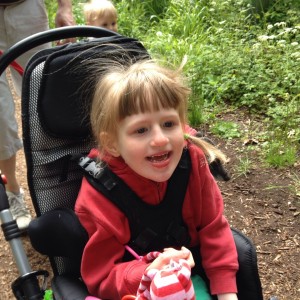 This is Twinkle, my gorgeous, happy 4.5 year old little girl who just happens to have a genetic condition that all the standard NHS tests (and we have had a lot!) have so far been unable to identify.
This is Twinkle, my gorgeous, happy 4.5 year old little girl who just happens to have a genetic condition that all the standard NHS tests (and we have had a lot!) have so far been unable to identify.
I just don’t know where all the time has gone since our perfect little bundle was born and our ideal newborn baby bubble was quickly burst by an echocardiogram, a skull x-ray and some chromosome blood tests. The beginning of a very confusing time and a long list of hospital appointments and tests, over many months and years, as each came back ‘in the normal range’, ‘clear’ or ‘negative’.
Living without a diagnosis can be very isolating, and especially as Twinkle was our first child, it was hard to tell if symptoms, or more accurately thing’s she wasn’t able to do, were anything to be concerned about. As the tests seemed to say otherwise, we often felt like neurotic first time parents.
It wasn’t until we were entered on the DDD study (Deciphering Developmental Disorders) and found the SWAN UK community (when our little girl was around 18 months old) that we really acknowledged we were not a typical family.
Twinkle has a long list of symptoms all of which can also be attributed to many other conditions so they don’t really help give a full picture of her condition and mean that we do not know what the future might hold (in some ways liberating, as there are no preconceptions) but can also be very difficult – Will she walk? Will she talk? Will she be able to live independently? Will she develop any associated health problems? Will she have a shorter life!!!?
It’s quite likely you will have a number of constituents affected by a rare, genetic or undiagnosed conditions. It is thought that about 50% of children with learning disabilities and 60% of children with multiple congenital problems do not have a definitive diagnosis to explain the cause of their difficulties.
Rare and genetic conditions are a significant cause of illness – 1 in 17 people will be affected by a rare condition at some point in their life and 4 in 100 babies in the UK are born with a genetic condition. It is estimated that 6,000 children are born a year with a genetic condition that will remain undiagnosed. SWAN UK made this lovely little film for undiagnosed children’s day earlier this year to helps to spread awareness of just how common this is:
It would seem that we just don’t know how much we don’t know about genetics! There is such a long long way to go in this area of medical research and, in the meantime, a long way to go to make sure it is acknowledged across the board that even if the tests don’t find an answer, it doesn’t mean there’s not condition there, and that the family affected still needs the same level of help, support, treatment and therapies as those who are diagnosed with known conditions.
I am writing to you both as my constituency MP, and the MP of the constituency where my little girl will be attending special school. As we fall the remit of both of your constituencies for different aspects of Twinkle’s care I felt it was important to write to both of you, and of course having MPs of different parties involved in these groups is so important!
The key aims of the APPG will be to increase awareness of rare, genetic and undiagnosed conditions in parliament and help to ensure that patients and their families, families like ours, who are affected by these conditions, have access to appropriate care and support.
Having had our brief 3 seconds of fame at the end of last year! (We and another local family were interviewed as a families potentially affected by a new genetic test being developed here in Cambridge). I know that Cambridge is very much a centre of excellence in the area of genetic research and very possibly the source of amazing discoveries in the future which will help families like ours! It’s seems to me that this is not just a subject close to our family and our SWAN UK & RARE DISEASE UK community’s heart but also a subject right up Cambridge’s street! I do hope you feel the same and will consider joining the APPG.
The charity Genetic Alliance UK will be providing secretariat to the APPG, so please get in touch with them by emailing emily.muir@geneticalliance.org.uk or by calling 020 7704 3141, and they can provide you with additional information.
I very much look forward to hearing from you.
Yours sincerely,
Vaila & the Morrison family
monkeys and swans
For Undiagnosed Children’s Day 2015
We said goodbye to EJ’s standing frame last week (the monkey – imaginatively named after the big plywood monkeys which sandwiched her). EJ is getting much stronger at standing up herself, so we prefer to practice dynamic standing with her, supporting her to play at her little kitchen or trying to encourage her to cruise. She has also ‘graduated’ into a gait trainer/walking frame (although at the moment she mostly sits down in it!) and has begun taking a few steps at a time.
EJ hasn’t been using the monkey for a while, so it has been kicking around our kitchen tripping me up and generally getting in the way (they are not small things!). I was really looking forward to it being taken away, help another little person, and give us some much needed space back (the gait trainer is also not a small thing!). However, as I was giving it a wipe down, and checking all the bits were there ready to be picked up, I got a bit emotional!
EJ’s condition is not something that we knew about when she was born.
All her antenatal tests were all ‘normal range’. There were a few hairy moments during labour and her birth and in the first few weeks, some of which prompted the paediatrician to order some chromosomal tests before we left the hospital in the first week, but they came back ‘all clear’ – oh ok!? – she was just a typical new baby then?
We were first time parents, so had nothing to compare our experience with, but gradually things didn’t feel as they should.
EJ began missing the milestones in the little red book and falling behind her little baby peers. It was noted at her first couple of checks but we were told it was probably nothing, they all develop differently (true), she is just a little delayed and a little floppy (I guess….?), it could be her her reflux (oh! that make sense), it could be the hole in her heart making her body work harder (so when that’s repaired……?)…..
But she’s falling further behind – ok – more tests (more ‘normal’ results)…….
It was all very vague and confusing….
She was medically ‘normal range’ but she wasn’t following the charts, she wasn’t keeping up with her peers and she didn’t have the muscle control she should have by now. It was never made clear that actually it was quite common for children with genetic conditions to get an all clear on the tests currently available (approx 6000 a year in fact!). Nobody said to us (given her symptoms) that it was highly likely she had some form genetic disorder no matter what the results of the tests. We were left feeling confused, even neurotic and paranoid, with nowhere to go to ask. The doctors were all great individually, and of course asked us if we had any questions, but we didn’t really know what the questions were!
It was when EJ was around a year old that we began to gather a selection of different specialists, referrals to therapists, and there were talks of developmental delays and low muscle tone, more tests (all with normal results). No use of the term disabled…… (so she’d catch up – right?)
The monkey arrived when EJ was about 21/22 months (shortly after she had begun to sit up unaided at 18 months). It was the first proper ‘disability aid’ that we had. Looking back now I suppose it was a symbolic moment in time. A tangible, physical object that marked our change in perception of how things were and how things were going to be for us. The way our lives were moving in a different direction to that we’d imagined.
EJ did have additional needs. She didn’t fit the baby book formula.
We continued going to mainstream toddler groups (and still do go when we can, as I think inclusion is very important for both EJ and for the other children) but until now we had been trying to fit in, conform, but we were really on a very different road. We couldn’t join in with the usual new parent chat (weaning, crawling, first words etc).
Sometimes you just need to be with people who ‘get you’.
It was another 9 months or so after the monkey arrived in our house that our geneticist suggested entering J into the DDD (Deciphering Developmental Delay) academic study. With the DDD pack there was a leaflet about a charity supporting families of children with undiagnosed conditions – SWAN UK (Syndromes Without A Name).
I went home, joined SWAN UK, and we found our fit! We found people who ‘got us’!
Our first few years would have been so much easier if we’d had that support, that wealth of knowledge and experience, that place to ask random questions, that comfort of knowing we were not the only ones.
We are all on such different, yet exactly the same, journey into the unknown – we are all swans families!
Friday 24th April is the 3rd Undiagnosed Children’s Day raising awareness – hopefully reaching parents who need SWANs support and putting a call out to the medical professionals who can point new families in the direction of such a much needed resource at such a vulnerable time in their lives.
SWAN UK is funded by a lottery grant until May 2016…..but we, and so many families, need it’s continuing support and so many new families starting that scary journey need SWAN to be there for them.
This post is part of the Undiagnosed Children’s Day BLOG HOP
playground fun
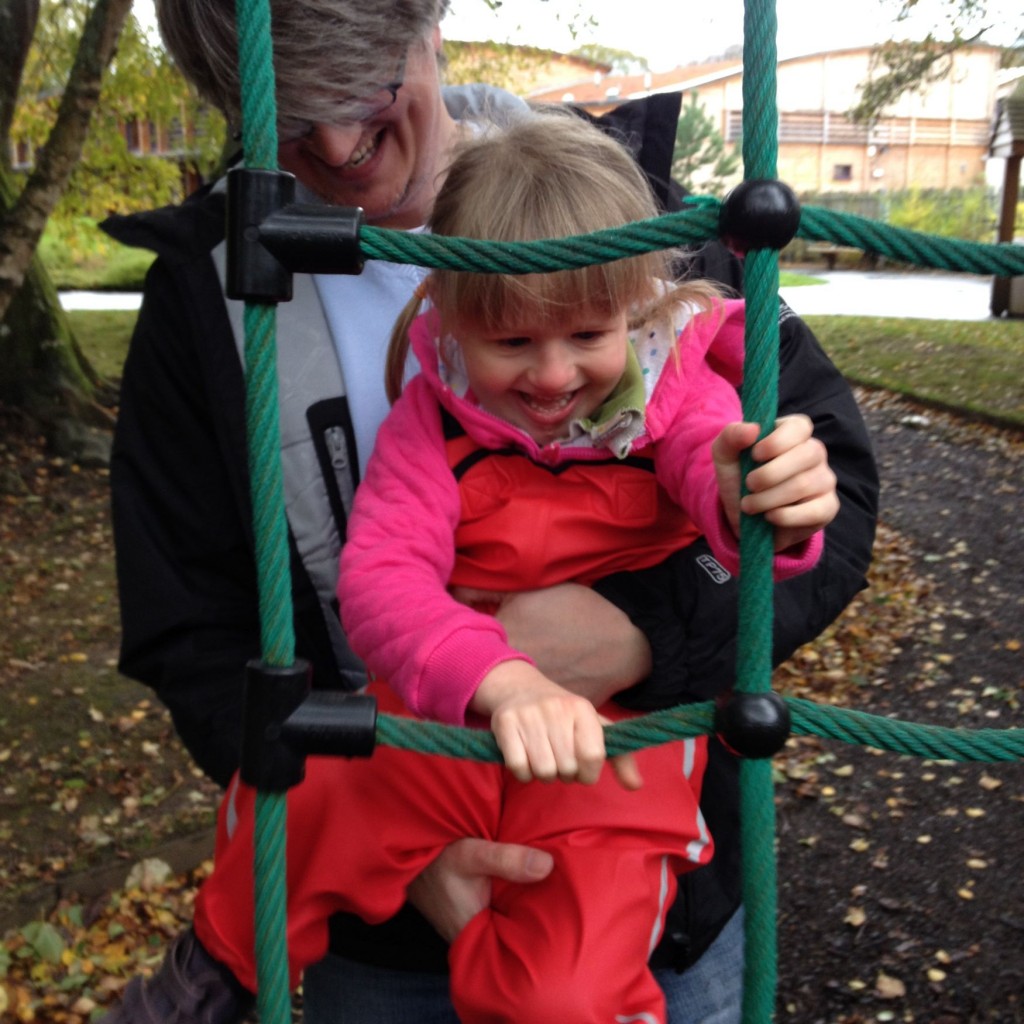
I spotted a poster on our village notice board a few weeks ago for a consultation event about a new children’s playground for the village, and (being both a mum and an architect!) I couldn’t stop myself from going along and to see what it was all about!
It was a really well attended event and exciting to see lots of families engaging with the ideas being displayed! Lots of drawing and children and parents filling out comments forms.
There were 4 concepts tabled by 4 different companies (Hags-SMP, Kompan, Playdale and Wicksteed).
The proposals all catered for a large age range (toddler to 12ish years old) and all of them had fun suggestions. I don’t think I really favoured any one particularly over the others – there were similarities and differences that made them all interesting in different ways.
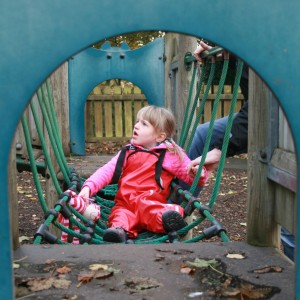
Our request was (surprise surprise!) for the final design to consider inclusive play and equipment as much as possible!
I am passionate about EJ being able to join in activities with her friends and siblings (in her own way). However, I think it’s also so valuable for all children to have the opportunity to meet and interact with children with differences, because the more they do, the less ‘different’ disability becomes.
It would be fantastic if more playgrounds featured inclusive activities and equipment, that everyone can use. This approach is not just about enabling children with additional needs, but also allowing siblings and friends of varying ages, and even mum or dad to join in, and play together. Inclusive play also often equates to more imaginative play, as children find new ways to use equipment and join in with activities.
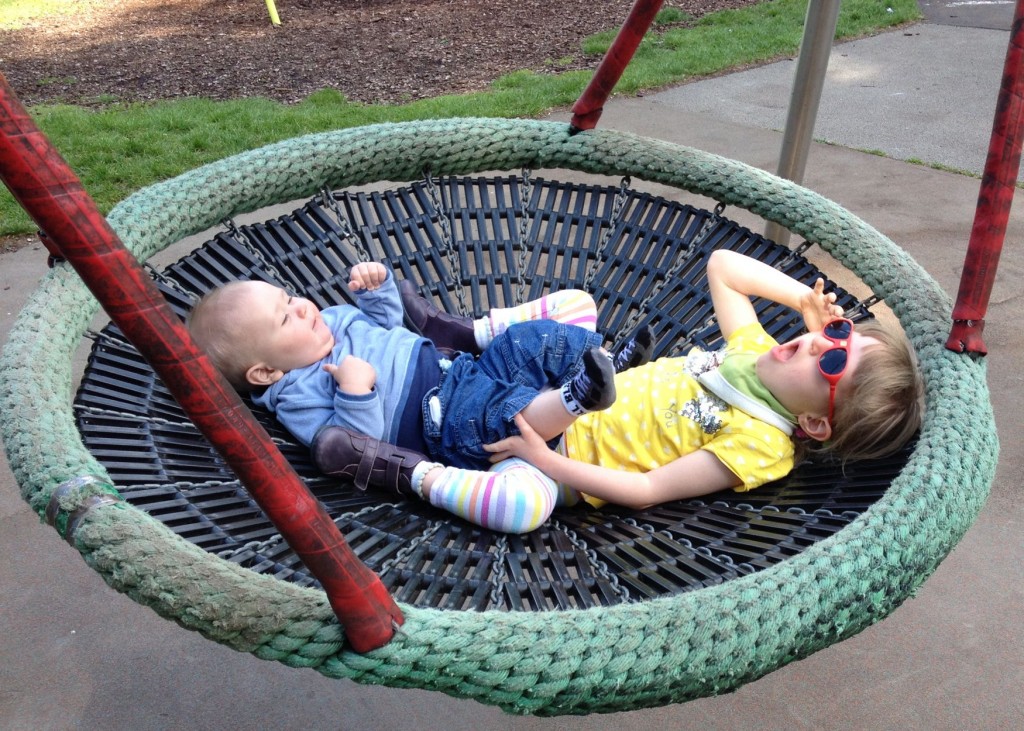 Playgrounds are really important to all children’s development (balance, body awarenes etc) but for children like EJ with sensory processing disorder, vestibular stimulation (things like swinging, spinning around, bouncing) is particularly important – it’s all fun therapy and learning!
Playgrounds are really important to all children’s development (balance, body awarenes etc) but for children like EJ with sensory processing disorder, vestibular stimulation (things like swinging, spinning around, bouncing) is particularly important – it’s all fun therapy and learning!
I’m always on the lookout for places that EJ can join in with her brother and cousins. I have a list of our favourite playground equipment on pinterest, that I try to spot when we are out and about and passing new places, and I’m also starting to gather ideas on my pinterest boards for fun (and lots of sensory) things to do in our own garden (some are more achievable than others! – unless I get Alan Titchmarsh’s team to come and sort us out!).
In the playground, we love:
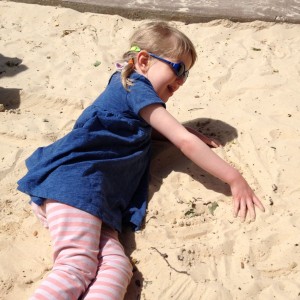
- Swinging – who doesn’t love a swing! EJ is too tall now for a toddler swing so we particularly like the big basket type that she can lie in safely.
- Spinning – there are lots of cool accessible roundabouts on the market now which are flush with the ground and that you can push a pram/buggy/wheelchair onto.
- Bouncing – trampolines, rope bridges, nets (again, fun for everyone!)
- Textures – EJ loves the feel of sand!
- Scrambling – Things to crawl over and scramble about on (like mounds and tunnels)
My favourite new idea from the day was adding a saftey net below a rope pyramid climbing frame which EJ could lie or sit on and would be able to feel the bouncing and vibrations from other children climbing on the ropes – she would love that!
Meanwhile, 16 month old EW spend most his time monopolizing the little slide, so I guess he was trying to tell us his preferences lie there!
being undiagnosed
We are an average family of 4 (Mum, Dad, a 4 year old girl and a 1 year old boy, oh and two dogs!), apart from the fact that our gorgeous 4 year old girl has an undiagnosed condition.
Other than a hole in the heart and a bacterial infection at birth (both pretty common newborn problems) EJ’s condition wasn’t immediately apparent, only gradually coming to light as she began to collect other ‘symptoms’ and began to miss her developmental milestones.
It took a while for us to really twig that things were going to be different for us. In fact, being undiagnosed we still really don’t know how differently things will pan out in the future. She has had all the normal tests the NHS can offer, chromosome anaysis, micro-array, MRI scan etc but no underlying reasons have been identified. EJ’s condition results in Global Development Delay and Sensory Processing Disorder.We now understand her condition affects of her overall sensory processing (visual, auditory, cognitive) which, along with hypotonia and is hyperflexiblity, has slowed her general development.
I have mixed feelings about the need for a definitive diagnosis (or not!).
In many ways being undiagnosed is a positive thing. We (and everyone else around her) have no preconceptions about how EJ will be in the future so we can just ‘get on’ with giving her the best chances we can for her to develop in her own way –
she is just our unique little girl
However there are also are lots of reasons why having a diagnosis IS important to us. A diagnosis could give us some vital information about potential health and development issues that could occur in the future which would help with future planning (including our house adaptations). It could allow us access to a support network of other children and families with the same issues and perhaps an exchange of ideas on particular therapy options, health issues, prognosis. Also from a totally administrative point of view, it would give us something to enter in the box marked ‘diagnosis’ in the miriad of forms we have to fill in to access therapy, education, funding and also give us a nice quick response to the quizzical looks from new people we meet….. ‘Undiagnosed Condition with Sensory Processing Disorder and Mobility Impairments’ is quite a mouthful!
EJ being undiagnosed has also meant that for a long time our journey was very confusing, and at times pretty lonely and isolating, as we didn’t ‘fit’ anywhere, not in mainstream and not in any particular special needs group…..that is until we found SWAN UK!
We were given a leaflet about SWAN by our genetics department as part of the package of information given to parents of children entering the DDD study (Deciphering Developmental Delays: an academic study looking into detailed DNA variations to try and diagnose rare genetic disorders). I popped straight online when I got home, joined the charity and found ourselves in the midst of a national network of families on the same (but often very different!) journey into the unknown! SWAN has given us a fantastic online community for chat and support…
in SWAN world being undiagnosed is the new normal….we fit!
twinkle twinkle media star
Twinkle is a SWAN, she has a ‘Syndrome Without A Name’.
Despite having had all the tests the NHS is able to offer, we still don’t know the reason for her neurological condition. She has been entered into detailed academic study called Deciphering Developmental Disorders (DDD) by her geneticist. This is a very long process as each variation in the DNA is studied (we submitted our samples 18 months ago and still no news!)!
SWAN UK (the fantastic family support charity we are members of) were recently contacted to see if a family local to Cambridge, and on the DDD study, would participate in an interview about their situation. We were interviewed by BBC Radio Cambridgeshire and BBC Look East a few weeks ago! The TV clip now on the BBC website (view here) includes a little clip of us and of another family, as the background for exciting developments in diagnosis for rare disorders coming out of the DDD study. Congenica, based in Cambridge, are developing new software which will allow a much more detailed and efficient diagnostic test to be offered than is currently available. This could be huge for families like ours!
